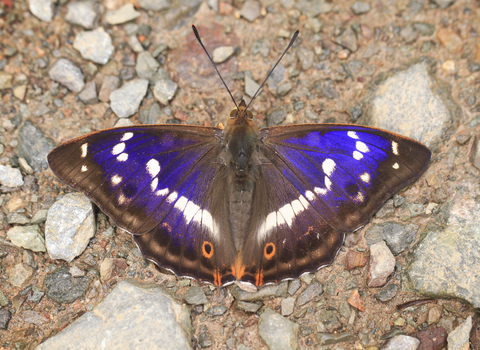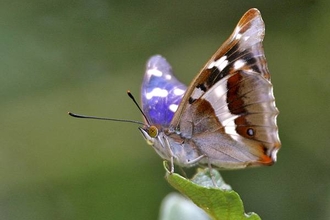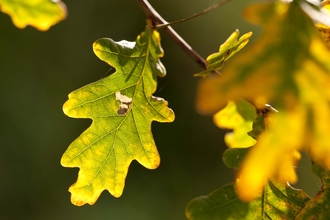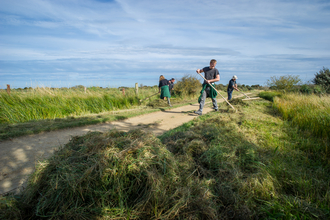
Purple emperor ©Frank Porch www.flickr.com/photos/prankf

Purple Emperor ©Margaret Holland
Purple emperor
The male purple emperor is a stunning butterfly with a brilliant purple sheen. Look for it feeding around the treetops in woodlands, or on damp ground, animal droppings or even carrion in the morning.
Scientific name
Apatura irisWhen to see
June to AugustSpecies information
Category
Statistics
Wingspan: 7.0-9.2cmConservation status
Protected in the UK under the Wildlife and Countryside Act, 1981.
Habitats
About
A strikingly beautiful butterfly, the purple emperoris only on the wing for a short period in late summer. A large butterfly of woodlands, it is well known for spending much of its time in the treetops feeding on aphid honeydew, so a pair of binoculars is handy if you want so spot this dazzling insect. Males may be seen flying to the ground mid-morning to feed on salts and sugars in damp puddles, on animal droppings or road surfaces, or even on rotting carcases. The caterpillars feed on mainly on goat willow, although crack-willow and grey willow are also used.How to identify
The male purple emperor is an unmistakeable glossy purple above, with white bands across its wings and orange-ringed eyespots under the brown forewings. The female is brown and similar to the white admiral in appearance, but also has orange-ringed eyespots under the forewings. Females are larger than males and both are larger than the more common white admiral.Distribution
Found in southern England.Did you know?
Male purple emperors are known to travel up to a kilometre from their feeding areas to gather in 'master trees' (usually oak, but sometimes beech or conifer are used) where they compete for females. These trees are often at a high point in the wood and will be used year after year.How people can help
The Wildlife Trusts manage many woodland nature reserves sympathetically for the benefit of all kinds of butterflies, including the purple emperor. A mix of coppicing, scrub-cutting, ride maintenance and non-intervention all help woodland wildlife to thrive. You can help too: volunteer for your local Wildlife Trust and you could be involved in everything from traditional forest crafts to surveying for butterflies.Purple emperor (https://vimeo.com/438816630)
A male purple emperor feeding on dog poo ©Tom Hibbert



